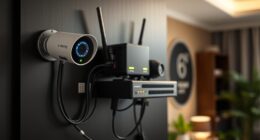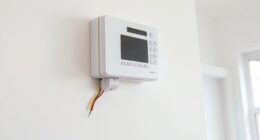To start choosing a home security system, assess your specific needs and vulnerable areas such as doors and windows. Consider your budget, including system prices, installation fees, and monthly monitoring costs. Determine if you desire a DIY option for flexibility or professional installation for convenience. Compare professional monitoring services with self-monitoring options. Finally, research recommended systems like SimpliSafe, Ring Alarm, or ADT to discover the ideal fit. For the best decisions and comprehensive insights, explore all the details that could affect your security system choice.
Key Takeaways
- Assess your home's vulnerable areas and specific security concerns based on local crime rates and valuable items.
- Determine your budget, considering system prices, installation fees, and monthly monitoring costs.
- Choose between DIY systems for cost savings or professional installation for expert setup.
- Evaluate monitoring options: professional services for 24/7 surveillance or self-monitoring to eliminate monthly fees.
Assess Your Security Needs
When evaluating your security needs, start by reviewing your location and identifying vulnerable areas around your home. Focus on spots like back doors and first-floor windows, as these are often prime entry points for intruders.
Additionally, consider incorporating advanced features such as top-rated garage door openers that can enhance your home's security. Next, pinpoint your specific security concerns, taking into account factors like high crime rates in your area or the presence of valuable items inside your home.
Consider additional features that can enhance your security, such as fire alarms, motion detectors, smart locks, and glass-break sensors, especially for sliding doors. These features can provide an added layer of protection, tailored to your unique circumstances.
Decide whether a DIY system or professional installation is right for you. DIY systems like Ring Alarm and SimpliSafe are great for quick setups and are often budget-friendly for smaller homes. However, professional installation may be more suitable if you have complex needs.
Always keep your budget in mind when selecting a home security provider. Research different options and be aware of monthly monitoring fees, which can vary greatly. By taking these steps, you can effectively review your security needs and choose a system that best fits your lifestyle.
Budget and Cost Considerations

Understanding your budget and the costs associated with a home security system is vital after evaluating your specific security needs. Home security system prices can vary widely, with base packages starting around $139.99 and going up to $599.99. Installation fees typically range from $49 to $249.99, and these may be included in the overall cost, especially if you opt for professional installation.
When considering your budget, don't overlook the monthly monitoring costs, which can be as high as $49.99, though self-monitoring options are available with no monthly fees. Here's a quick cost breakdown:
| Cost Type | Estimated Range |
|---|---|
| Home Security System Prices | $139.99 – $599.99 |
| Installation Fees | $49 – $249.99 |
| Monthly Monitoring | $0 – $49.99 |
| Financing Options | Interest-free plans available |
| Hidden Fees | Varies by provider |
It's essential to review contract requirements and potential hidden fees, as these can greatly impact your overall expenditure. By carefully considering these factors, you can better align your home security choices with your budget.
Installation Options

Choosing the right installation option for your home security system can greatly impact its effectiveness and your overall satisfaction.
You have two primary installation options: professional installation and DIY installation.
Professional installation usually incurs additional costs ranging from $99 to $199, but it provides expert setup and guarantees ideal equipment placement for enhanced security coverage. Installation times can vary from 30 minutes to 3 hours, depending on the system's complexity. Additionally, checking for certifications and insurance can help guarantee that you select a reputable service provider should you choose professional installation.
On the other hand, if you prefer a more hands-on approach, DIY installation might be the way to go. Many DIY systems come pre-programmed for easier setup, allowing you to save on installation costs. However, consider your comfort with technology; DIY systems require some technical skills. Luckily, many DIY options offer remote installation support, giving you access to guidance as you set up your security system.
Ultimately, the choice between professional and DIY installation hinges on your budget, technical comfort, and how much control you want over the setup process. Weigh these factors carefully to choose the installation option that best suits your needs.
Monitoring Choices

Monitoring Choices
You have several monitoring choices for your home security system, each offering unique benefits and responsibilities. Professional monitoring services provide 24/7 surveillance, ensuring immediate emergency response, but they typically come with monthly fees ranging from $5 to $65 or more. If you're looking for affordable plans, companies like SimpliSafe start around $10/month.
Additionally, just as with pet care, maintaining a secure environment requires understanding the potential risks and the best practices to mitigate them, such as cat safety considerations for your furry friends.
On the other hand, DIY security systems like Ring Alarm and Abode let you choose self-monitoring options that don't require monthly fees. However, this puts the responsibility of managing alerts on you, which can be a double-edged sword. The reliability of self-monitoring apps can vary, so it's essential to test them for effective detection before relying solely on them.
Many systems offer customizable alerts, allowing you to tailor notifications based on your security needs and preferences. This flexibility can enhance your monitoring experience, but remember that the quality of your chosen monitoring option will directly impact your system's reliability.
Ultimately, weigh the pros and cons of each choice to find the right fit for your home.
Recommended Home Security Systems

When evaluating home security systems, it's essential to take into account options that best fit your lifestyle and budget.
Consider how safety features can enhance your home environment, especially for aging family members who may require extra support, like Aging With Dignity – In-Home Care Tips.
Several systems stand out as the Best Home Security Systems for various needs:
- SimpliSafe: This is an affordable DIY option, with starter kits around $280 and monitoring plans starting at just $10 per month.
- Vivint: Ideal for those wanting smart home integration, it offers flexible build-out options and monitoring costs between $30 and $45.
- Ring Alarm: Known for its competitive subscription plans, this system requires no long-term contract and is perfect for budget-conscious consumers.
If you prefer professional monitoring, ADT is renowned for its reliability, although it typically comes with higher upfront costs and long-term contracts.
Choose wisely based on your needs for DIY home security systems, smart security, and home automation capabilities, considering what monitoring plans and security devices suit you best.
Frequently Asked Questions
How to Choose a Security System for a Home?
To choose a security system for your home, assess vulnerabilities, compare costs, and decide between DIY or professional installation. Evaluate monitoring options and check reviews to guarantee reliability and fit for your specific needs.
What Is the Best Home Security System Brand?
When you consider the best home security system brand, think about reliability, technology, and affordability. ADT's trusted monitoring, Vivint's smart home features, and SimpliSafe's budget-friendly plans all cater to your unique security needs.
How Many Sensors Do I Need for Home Security?
You need sensors based on your home's size and layout. For a small apartment, 2-4 sensors suffice, while larger homes may require 10 or more to effectively secure all entry points and vulnerable areas.
How Much Does a Security System Add to Home Value?
Imagine boosting your home's value by 5% just by adding a security system! It's true—buyers crave safety and peace of mind, making your investment not just smart, but a potential goldmine for future resale.
What Factors Should I Consider When Choosing a Home Security System?
When looking to choose the right home security system, consider factors such as your budget, the size of your home, and the level of protection you need. Think about whether you want a monitored or unmonitored system, and whether you want additional features such as video surveillance or smart home integration.
Conclusion
Choosing the right home security system doesn't have to feel like rocket science.
By evaluating your needs, setting a budget, and exploring installation and monitoring options, you can find a solution that fits your lifestyle.
Remember, a secure home isn't just a luxury; it's your sanctuary against the chaos outside.
So, take the time to make an informed choice, and you'll be well on your way to feeling like the most protected homeowner on the block!









